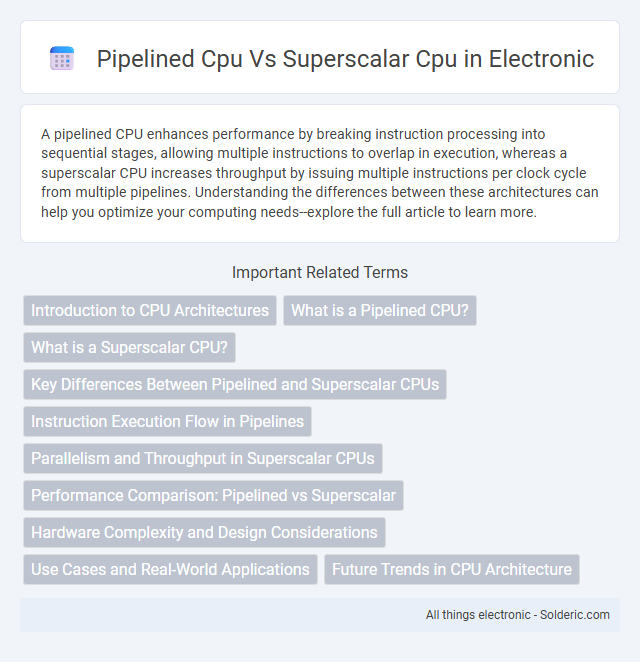A pipelined CPU enhances performance by breaking instruction processing into sequential stages, allowing multiple instructions to overlap in execution, whereas a superscalar CPU increases throughput by issuing multiple instructions per clock cycle from multiple pipelines. Understanding the differences between these architectures can help you optimize your computing needs--explore the full article to learn more.
Comparison Table
| Feature | Pipelined CPU | Superscalar CPU |
|---|---|---|
| Execution Approach | Processes instructions sequentially in stages | Executes multiple instructions simultaneously per clock cycle |
| Instruction Throughput | Improved by breaking instruction execution into pipeline stages | Higher throughput via parallel instruction issue |
| Hardware Complexity | Moderate, with pipeline stage registers | High, requires multiple execution units and complex control logic |
| Performance | Increases instruction throughput but limited by pipeline hazards | Significantly higher performance by exploiting instruction-level parallelism |
| Instruction Issue Rate | One instruction per clock cycle | Multiple instructions per clock cycle |
| Hazard Handling | Pipeline hazards like data, control, and structural hazards | Complex hazard detection and dynamic scheduling mechanisms |
| Example CPUs | Early RISC processors, Intel 8086 pipelining | Modern processors like Intel Pentium, AMD Ryzen |
Introduction to CPU Architectures
Pipelined CPUs improve instruction throughput by dividing execution into sequential stages, allowing multiple instructions to overlap in processing. Superscalar CPUs enhance performance further by dispatching multiple instructions per clock cycle to parallel execution units, exploiting instruction-level parallelism. Both architectures aim to increase CPU efficiency, with pipelining focusing on instruction overlap and superscalar design enabling simultaneous multi-instruction execution.
What is a Pipelined CPU?
A pipelined CPU divides instruction execution into distinct stages, such as fetch, decode, execute, and write-back, allowing multiple instructions to be processed simultaneously in different stages. This improves instruction throughput and overall CPU efficiency by overlapping operations without waiting for one to finish before starting another. Your system benefits from reduced instruction latency, though performance gains depend on pipeline depth and hazard management.
What is a Superscalar CPU?
A superscalar CPU executes multiple instructions per clock cycle by leveraging multiple execution units, enhancing instruction-level parallelism beyond pipelined CPUs, which process one instruction per stage sequentially. Unlike a pipelined CPU that splits instruction execution into stages, a superscalar processor issues several instructions simultaneously, improving throughput and efficiency. Common implementations include multiple ALUs, FPUs, and load/store units working concurrently to maximize CPU performance.
Key Differences Between Pipelined and Superscalar CPUs
Pipelined CPUs process multiple instructions by breaking them into stages, allowing one instruction per clock cycle to be in each stage, which improves throughput but executes instructions sequentially. Superscalar CPUs issue multiple instructions per clock cycle by using multiple execution units, enabling parallel instruction execution and higher performance. Understanding these key differences helps you optimize system performance by selecting a CPU architecture that matches your workload demands.
Instruction Execution Flow in Pipelines
Pipelined CPUs divide the instruction execution process into discrete stages such as fetch, decode, execute, memory access, and write-back, allowing multiple instructions to be processed simultaneously at different stages. Superscalar CPUs extend this concept by dispatching multiple instructions per clock cycle to parallel functional units, increasing throughput beyond a single instruction pipeline. The instruction execution flow in pipelined CPUs is linear and stage-dependent, whereas superscalar processors dynamically schedule instructions to optimize parallel execution and minimize hazards.
Parallelism and Throughput in Superscalar CPUs
Superscalar CPUs achieve higher parallelism and throughput by issuing multiple instructions per clock cycle through several execution units, unlike pipelined CPUs that process one instruction at a time across different pipeline stages. This architectural design enables superscalar processors to exploit instruction-level parallelism more effectively, reducing idle execution units and increasing instructions completed per cycle (IPC). Enhanced throughput in superscalar CPUs results from simultaneous instruction dispatch, issue, and completion, significantly boosting performance in comparison to traditional pipelined architectures.
Performance Comparison: Pipelined vs Superscalar
Superscalar CPUs execute multiple instructions per clock cycle by dispatching them to multiple execution units, significantly enhancing instruction-level parallelism compared to pipelined CPUs, which process instructions sequentially in stages. While pipelined processors improve throughput by overlapping instruction phases, superscalar architectures boost performance by issuing several instructions simultaneously, reducing execution time. Your system's performance can dramatically increase with a superscalar CPU if workloads contain parallelizable instructions that exploit multiple functional units effectively.
Hardware Complexity and Design Considerations
Pipelined CPUs feature a straightforward hardware design with sequential instruction stages, enabling improved throughput and simplified control logic. Superscalar CPUs require more complex hardware, including multiple execution units, sophisticated instruction dispatch, and hazard detection mechanisms, increasing design complexity and power consumption. Your choice depends on balancing the enhanced performance of superscalar architectures against the streamlined design and efficiency of pipelined CPUs.
Use Cases and Real-World Applications
Pipelined CPUs are widely used in embedded systems and general-purpose processors where efficient instruction throughput is essential for tasks such as mobile devices and basic computing applications. Superscalar CPUs find their primary application in high-performance computing environments, including gaming consoles, servers, and workstations, where parallel instruction execution significantly enhances processing speed. Both architectures improve CPU efficiency, but superscalar CPUs are preferred in scenarios demanding intense multitasking and complex computations.
Future Trends in CPU Architecture
Future trends in CPU architecture emphasize increasing instruction-level parallelism through advanced superscalar designs incorporating wider issue widths and out-of-order execution units. Pipelined CPUs continue evolving with deeper pipeline stages and enhanced branch prediction to minimize hazards and increase clock speeds. Hybrid approaches combining pipelined cores with superscalar capabilities and speculative execution techniques are driving higher performance and energy efficiency in modern processors.
pipelined cpu vs superscalar cpu Infographic

 solderic.com
solderic.com